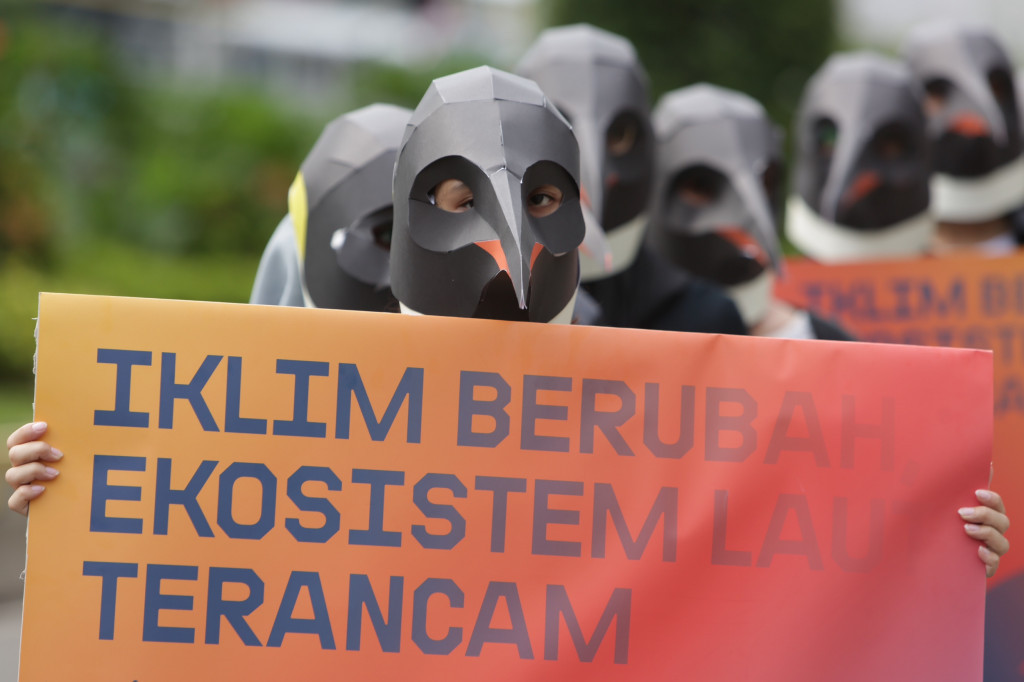Indonesia Net-Zero Emissions in 2070: Is It Too Late?

Illustration of Green Peace activists with penguin costumes while protesting in Jakarta. Photo: Wendra Ajistyatama/JP
The Paris Agreement is a momentum international agreement on climate change. Countries’ pledges are stated in their NDCs (Nationally Determined Contributions) for the period 2020-2030 including Indonesia who pledged to reduce greenhouse gas emissions by 29% by 2030 through its own efforts or by 41% with international assistance. According to the 2018 Second Biennial Update Report, Indonesia needs US$ 247.2 billion (about Rp. 3,461 trillion) in order to reach the Paris Agreement objective. This number is higher than the one provided by the National Economic Recovery Program (PEN).
Meanwhile, According to Bappenas’ estimates, achieving net-zero emissions in 2045 and 2050 will result in overall actual GDP growth rates of 6.21% and 6.06%, respectively from 2021 to 2045. In comparison to business as usual, a net-zero scenario could raise annual GDP by 2% and income per capita by up to 2.5 times. In pursuing net zero carbon emissions, Indonesia’s Ministry of Energy and Mineral Resources (ESDM) will launch a decree to turn the country’s remaining diesel-fired power plants into renewable energy projects. The conversion projects will be carried out in phases, with the final phase taking place in 2025-2026. The authorities intend to begin by replacing 358 diesel-fired power plants totalling 307 MW with solar power plants.
Simultaneously, The New and Renewable Energy Mix in 2020 was recorded at only 11.51%, missing the target of 13% (Agung, 2021). Even though the mix is still far from the target that must be achieved in 2025, which is 23%. Inconsistent policies on New and Renewable Energy will hamper this projection and become unprofitable. In 2023-2024, the first phase is projected to be completed. Then, Solar power plants with storage or solar power plants hybridised with diesel may be used. PT PLN, Indonesia’s state-owned power utility, plans to build renewable energy projects at 2,130 diesel-fired power plants with a combined capacity of 5.2 GW. Indonesia aims to generate 23% of total power capacity from renewables by 2025 (roughly 41 GW), and at least 28% by 2038. The country’s total capacity is 69.9 GW, with coal accounting for 52%, gas for 28%, oil for 9%, hydroelectricity for 8%, and geothermal for 3% (end of 2020) (Enerdata, 2021).
Although in the zero-carbon emission scenario Indonesia will stop the construction of fossil energy-based power plants in the next few years, the primary energy mix of coal power plants is still dominant at 62.38% and will continue to increase throughout the 35,000 Megawatt (MW) project and the Fast Track Program (FTP) 2 of 7,000 Megawatt (MW) will be completed in 2023.
Source: Ministry of Energy and Mineral Resources strategic plan 2020-2024
Moreover, In the Decree of the Minister of Energy and Mineral Resources No.66.K / HK.02 / MEM.B / 2021 concerning Amendments to the Decree of the Minister of Energy and Mineral Resources No.255.K / 30 / MEM / 2020 concerning the Fulfillment of Domestic Coal Needs in 2021, officially the Ministry of Energy and Mineral Resources raised the coal production target by 75 million tons to 625 million tons from the initial target of 550 million tons (Umah, 2021). This reflects the latest Decree of the Minister of Energy and Mineral Resources is even more expansive than the strategic plan of the Ministry of Energy and Mineral Resources 2020-2024. This is also in contrast to President Joko Widodo’s speech at the Climate Summit that Indonesia will target to decarbonise by 2030. It also illustrates that Indonesia’s 2070 Net Zero Emission target is inconsistent and not in line with the 2050 target suggested by the IPCC.
The dominance of coal-fired power plants that are continuously being intensified to encourage the industry will cripple Indonesia to achieve the NZE target in 2050 recommended by the IPCC. As a decision-maker, the Indonesian government must comprehend the sectors involved in the decarbonization process as we enter the energy transition age. From this year through 2030, Indonesia will need to invest US$20-2520 billion a year, rising to US$60 billion per year between 2030 and 2040 to meet this ambitious goal.
Decarbonization strategy
The cycle of defining material end-use needs, design to meet them, production, use and reuse, recycling, or disposal
Source: Bataille (2020)
Improved process efficiency through ecodesign and rewriting of building rules and guidelines to actively decrease the use of major GHG-intensive materials, optimize component lifetime and reusability, all without losing utility or safety, is a core decarbonization technique. Thus, a policy package addressing all aspects of decarbonizing heavy industry must consider how to decarbonize demand by fostering material efficiency and enhanced circularity, that will help reduce emissions from internally and externally built facilities using commercialized technologies, as well as driving best available technology (BAT) to zero emissions as soon as possible, ideally by the end of the decade.
In the short term, all stakeholders must endeavour to increase the quantity and quality of GHG-intensive products recycled. In-transition and less-developed regions should promote professional industrialization of raw material processing, while more developed areas should focus on institutional education and building code reforms needed for better material design and more recycling. Hence, building, vehicle, and infrastructure design must be reprioritized for long life, reduced use of currently GHG-intensive materials like steel and cement, and “de-constructability” for component reuse and maximum recycling, all without sacrificing usability or safety.
References:
Agung, F. (2021, January 15). Meleset dari target, bauran EBT di tahun 2020 baru capai 11,51% . Retrieved from Kontan: https://industri.kontan.co.id/news/meleset-dari-target-bauran-ebt-di-tahun-2020-baru-capai-1151
Bappenas. (2021). Annual Total Real GDP Growth 2021-2045. Jakarta: Bappenas.
Umah, A. (2021, April 14). Resmi! Target Produksi Batu Bara 2021 Naik Jadi 625 Juta Ton . Retrieved from cnbc Indonesia: https://www.cnbcindonesia.com/news/20210414113240-4-237742/resmi-target-produksi-batu-bara-2021-naik-jadi-625-juta-ton
PT. Perusahaan Listrik Negara. (2019). Rencana Usaha Penyediaan Tenaga Listrik PT. PLN (Persero) 2019 – 2028.
Bataille, C. G. (2020). Physical and policy pathways to net-zero emissions industry. Wiley Interdisciplinary Reviews: Climate Change, 11(2), e633.
Dhea Sarah Valeska is a fresh graduate of Public Policy and Management UGM and currently a project-based consultant for government institutions. She can be found on Instagram with the username @dheasarah.





